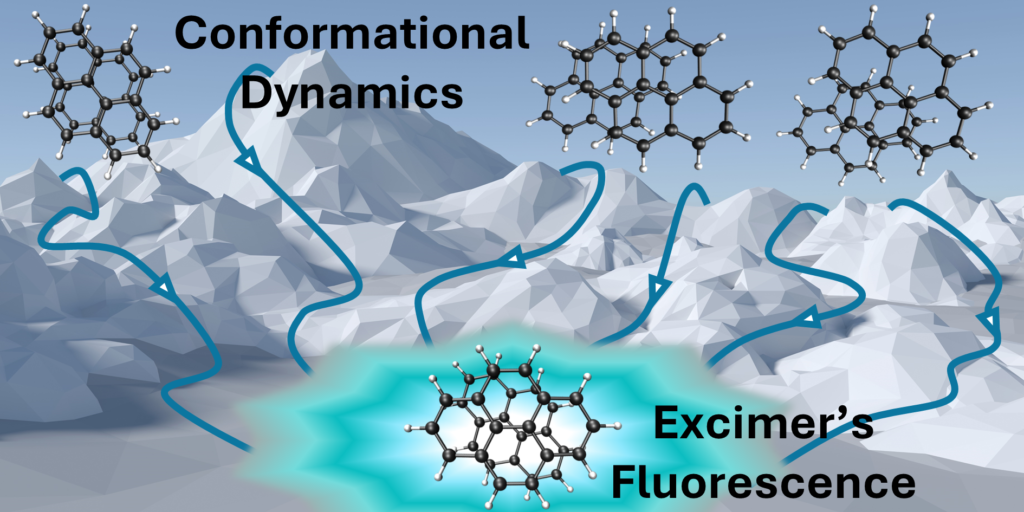TD-DFT and Machine Learning together decipher the competition between thermal relaxation and photoemission.
In brief:
- We identified multiple stable conformations of the pyrene excimer using TD-DFT and machine learning clustering methods.
- We demonstrated that structural reorganization towards the most stable conformer outcompetes radiative relaxation pathways.
- A dominant conformer, a stacked-twisted structure, dominates the excimer’s characteristic fluorescence.
Our latest paper, recently published in PCCP, goes deep into the intricate conformational dynamics of the pyrene excimer and its implications for fluorescence emission behavior. The excimer—a molecular aggregate formed exclusively in the excited state—has fascinated chemists for decades due to its unique, broad, red-shifted fluorescence. Despite this, the precise structural pathways and conformational states governing its behavior have long been a source of debate.
In this study, led by Giovanni Parolin from the University of Padua, we combined cutting-edge computational techniques—time-dependent density functional theory (TD-DFT) with advanced unsupervised machine learning—to map out the stable geometries of the pyrene excimer in its first excited state.
We developed a computational protocol to emulate the collisional process forming the excited dimer in many different configurations. By generating and optimizing numerous randomly generated initial configurations, we identified and categorized a diverse ensemble of dimer geometries. This work revealed that the excimer landscape is far from monolithic; instead, it encompasses multiple local minima, each with distinct structural and photophysical properties.
However, these local conformations don’t survive forever. After the excited dimer is formed, it can thermally reorganize into a more stable conformer or even dissociate. Does this transformation occur before fluorescence emission? We compared the isomerization rates to emission rates. We figured out that, no matter the initial conformer formed in the collision, at the time of fluorescence, the pyrene dimer would already be relaxed to the global minimum, a stacked-twisted excimer conformer.
Left: Many types of excited pyrene dimers arise from the collisional process. Right: At fluorescence, they have all already converted into a dominant species.
The stacked-twisted conformer is primarily responsible for the excimer’s characteristic red-shifted emission. Notably, its stability and rapid structural relaxation mean it competes effectively with radiative relaxation pathways, explaining why this conformation becomes the primary source of observed fluorescence. This kinetic funneling effect leads to a consistent emission profile, bridging the gap between theoretical predictions and experimental observations.
To provide deeper context, our analysis also highlighted how competing pathways, including radiative relaxation and conformational rearrangement, dictate the excimer’s photophysics. For example, while several clusters of conformers exhibited short-lived fluorescence, these were outpaced by rapid transitions towards the more stable stacked-twisted structure. This result underscores the idea that pyrene excimer fluorescence is a downstream response of complex conformational dynamics governed by both thermodynamic and kinetic factors.
Beyond their fundamental interest, excimers—particularly those based on pyrene—hold tremendous potential for practical applications. From organic electronics to molecular sensing, their tunable optical properties can be harnessed for technological innovation. By understanding and manipulating the structural evolution of excimers, we can inform new design strategies for functional materials and devices.
In conclusion, our work represents a significant leap in our comprehension of excimer photophysics. It demonstrates how theoretical modeling, combined with innovative data clustering methods, can elucidate the rich and dynamic behavior of molecular aggregates. We believe this research not only deepens our understanding of pyrene excimers but also opens doors to broader explorations in the chemistry of excited-state complexes.
To learn more about the methods, findings, and implications of our work, we invite you to read the full article.
MB
Reference
[1] G. Parolin, B. C. Garain, S. Mukherjee, G. Granucci, S. Corni, M. Barbatti, Conformational Dynamics of the Pyrene Excimer, Phys. Chem. Chem. Phys. (2024). 10.1039/D4CP03947E

